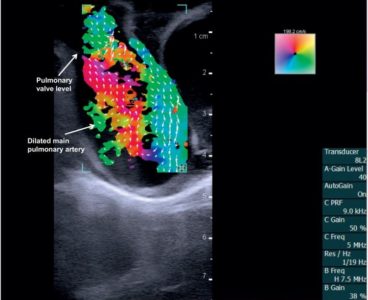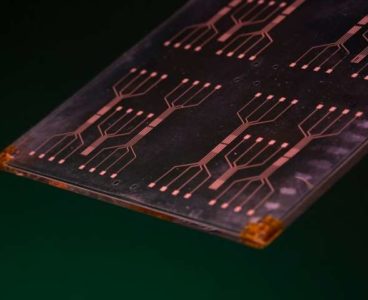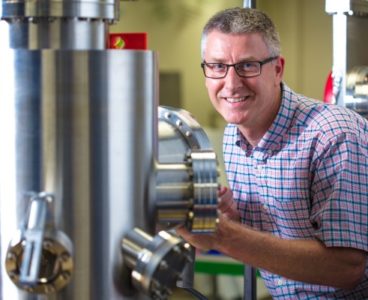Computer memory could become faster and cheaper thanks to research into a promising class of materials by University of Arkansas physicists. The scientists are studying bismuth ferrite, commonly abbreviated as BFO, a material that has the potential to store information much more efficiently than is currently possible. BFO could also be used in sensors, transducers…
Researchers Test New Imaging Method for First Time on Human Patients
A new study by biomedical engineering researchers at the University of Arkansas could significantly improve methods for detecting and diagnosing congenital heart disease in infants and small children. The researchers, collaborating with cardiologists at Arkansas Children’s Hospital in Little Rock, tested a new ultrasound technology called vector flow imaging for the first time on pediatric…
Researchers Reveal Spontaneous Polarization of Novel Ultrathin Materials
Many materials exhibit new properties when in the form of thin films composed of just a few atomic layers. Most people are familiar with graphene, the two-dimensional form of graphite, but thin film versions of other materials also have the potential to facilitate technological breakthroughs. For example, a class of three-dimensional materials called Group-IV monochalcogenides…
Overcoming Challenges when Exfoliating Novel 2D Materials
Ever since researchers at the University of Manchester used a piece of tape to isolate, or “exfoliate,” a single layer of carbon, known as graphene, scientists have been investigating the creation of and applications for two-dimensional materials in order to advance technology in new ways. Scientists have theorized about many different kinds of two-dimensional materials,…
A New Approach to Studying Nanodroplets
Researchers have found new methods to measure the internal pressure and surface tension of nano-sized drops of liquid like those involved in cloud formation and airborne pollutants to study how they behave in different environments. Understanding the function of these droplets in cloud formation is relevant to the study of climate change. Similarly, airborne pollutants…
Optical Properties of 2D Materials for Potential Advancements to Infrared Technology
‘Optically Pumped’ Laser Closer to Improving Processing Speed of Sensors
Imagine creating a material for the digital information highway that allows a fast lane of laser light that zips data past the traditional silicon chips. A multi-institutional team of researchers, led by University of Arkansas engineering professor Shui-Qing “Fisher” Yu and a leading Arkansas semiconductor equipment manufacturer, have made significant improvements to a new kind…
Research May Lead to New Source of Green Energy
Paul Thibado discovered that under the right circumstances, temperature changes caused by ambient heat makes graphene ripple and buckle. Now he’s using this idea to create an energy breakthrough: a device that harnesses the heat all around us to create electricity. The research of Paul Thibado, professor of physics at the University of Arkansas, has…
Nano Research Heralds a New Source of Green Energy
The research of Paul Thibado, professor of physics at the University of Arkansas, has shown that the motion of two-dimensional materials may be used as a source of clean, limitless energy. NTS Innovations (also known as Nanotube Solutions LLC), a nanotechnology company headquartered in East Peoria, Ill., has licensed this patent-pending technology from the university…
Clean Energy Created from Natural Motion of 2D Materials
The research of Paul Thibado, professor of physics at the University of Arkansas, provides strong evidence that the motion of two-dimensional materials could be used as a source of clean, limitless energy. Thibado and his students studied the movements of graphene, which is composed of a single layer of carbon. Thibado has taken the first…
How Does Chewing Affect Teeth on the Nanoscale?
Food leaves permanent traces on teeth. Cows chewing on grass, tigers tearing up a piece of raw meat and humans munching on tortilla chips all end up with tiny scratches and nicks on the enamel of their teeth. Examining these marks on the microscale — what researchers call “microwear” — has led to new discoveries…
Properties of Strained Graphene and Other Strained Materials
Physics Professor Publishes Review on Strained 2-D Materials
Salvador Barazza-Lopez, associate professor of physics at the University of Arkansas, is part of a team that published a review article on the properties of strained graphene and other strained two-dimensional atomic materials in the prestigious Reports of Progress in Physics, a review-style journal published by the Institute of Physics in the United Kingdom that has…
Researchers Develop Non-Flammable Graphene Membrane
University of Arkansas researchers have discovered a simple and scalable method for turning graphene oxide into a non-flammable and paper-like graphene membrane that can be used in large-scale production. “Due to their mechanical strength and excellent charge and heat conductivities, graphene-based materials have generated enormous excitement,” says Ryan Tian, associate professor of inorganic chemistry in…
Nickel Graphene Can Be Configured for Maximum Fracture Strength
In a new computational study published in The Journal of The Minerals, Metals & Materials Society, University of Arkansas engineering researchers found that nanocomposites composed of layers of nickel and graphene — a promising new material for flexible electronics devices — can be tuned for optimal fracture strength by manipulating the structural arrangement of the…
Spontaneous Mechanical Buckling in Freestanding Graphene Observed
An international team of physicists, led by researchers at the University of Arkansas, has observed spontaneous mechanical buckling in freestanding graphene using scanning tunneling microscopy, indicating it has potential to be a new electronic power source. The discovery advances the understanding of graphene, a two-dimensional material that is a mere single atom in thickness, and…
Physicists Observe Spontaneous Mechanical Buckling in Freestanding Graphene
An international team of physicists, led by researchers at the University of Arkansas, has observed spontaneous mechanical buckling in freestanding graphene using scanning tunneling microscopy, indicating it has potential to be a new electronic power source. The discovery advances the understanding of graphene, a two-dimensional material that is a mere single atom in thickness, and its…






